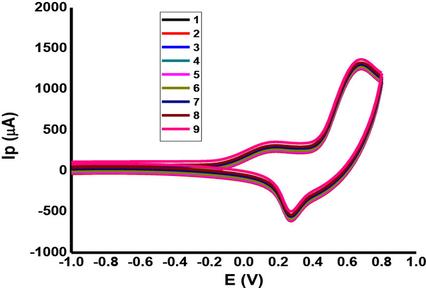当前位置:
X-MOL 学术
›
Electroanalysis
›
论文详情
Our official English website, www.x-mol.net, welcomes your feedback! (Note: you will need to create a separate account there.)
Ultra-Sensitive Amperometric Hydrazine Sensing via Dimethyl Glyoxomat Derived NiO Nanostructures
Electroanalysis ( IF 3 ) Pub Date : 2017-10-10 , DOI: 10.1002/elan.201700293 Munazza Arain 1 , Ayman Nafady 2, 3 , Abdullah M. Al-Enizi 2 , Tayyaba Shaikh 4 , Zafar Hussain Ibupoto 1 , Syed Tufail Hussain Sherazi 4 , Syeda Sara Hassan 5 , Muhammad Ishaque Abro 6 , Sirajuddin 4 , Manzoor Iqbal Khattak 7 , Raj Kumar 4
Electroanalysis ( IF 3 ) Pub Date : 2017-10-10 , DOI: 10.1002/elan.201700293 Munazza Arain 1 , Ayman Nafady 2, 3 , Abdullah M. Al-Enizi 2 , Tayyaba Shaikh 4 , Zafar Hussain Ibupoto 1 , Syed Tufail Hussain Sherazi 4 , Syeda Sara Hassan 5 , Muhammad Ishaque Abro 6 , Sirajuddin 4 , Manzoor Iqbal Khattak 7 , Raj Kumar 4
Affiliation

|
Here we report the synthesis of NiO nanostructures via glyoxomat assisted precipitation protocol using hydrothermal route under the influence of ammonia followed by annealing at 450 oC. These nanostructures were characterized via Scanning Electron Microscopy (SEM) and X-ray Diffraction (XRD) method. The morphological investigation of the finally prepared NiO revealed foam-like porous nanostructures. These NiO nanostructures were immobilized onto glassy carbon electrode (GCE) with nafion as binding material and used as highly sensitive and selective sensor for determining hydrazine in the range of 100–500 nM and 600–1600 nM with a calculated limit of detection (LOD) equal to 5 nM. The as prepared sensor was tested for the presence of various interfering species such as Na+, Cu2+, uric acid, hydrogen peroxide and glucose in the presence of equimolar concentration of hydrazine and negligible interference was noticed. The sensor was further tested for hydrazine detection using square wave voltammetry (SWV) however it only worked in the range of 50–1200 μM. Finally the sensor was successfully implemented for hydrazine determination in real water samples using amperometric protocol.
中文翻译:

通过二甲基乙醛酸衍生的 NiO 纳米结构实现超灵敏电流法肼传感
在这里,我们报告了在氨的影响下使用水热路线通过 glyoxomat 辅助沉淀协议合成 NiO 纳米结构,然后在 450 oC 下退火。这些纳米结构通过扫描电子显微镜 (SEM) 和 X 射线衍射 (XRD) 方法进行表征。最终制备的 NiO 的形态研究揭示了泡沫状多孔纳米结构。这些 NiO 纳米结构以 nafion 为结合材料固定在玻璃碳电极 (GCE) 上,并用作高灵敏度和选择性传感器,用于测定 100–500 nM 和 600–1600 nM 范围内的肼,并具有计算的检测限 (LOD)等于 5 nM。测试制备的传感器是否存在各种干扰物质,例如 Na+、Cu2+、尿酸、注意到在等摩尔浓度的肼和可忽略不计的干扰存在下过氧化氢和葡萄糖。使用方波伏安法 (SWV) 进一步测试了传感器的肼检测,但它只能在 50-1200 μM 的范围内工作。最后,该传感器成功地用于使用安培协议测定实际水样中的肼。
更新日期:2017-10-10
中文翻译:

通过二甲基乙醛酸衍生的 NiO 纳米结构实现超灵敏电流法肼传感
在这里,我们报告了在氨的影响下使用水热路线通过 glyoxomat 辅助沉淀协议合成 NiO 纳米结构,然后在 450 oC 下退火。这些纳米结构通过扫描电子显微镜 (SEM) 和 X 射线衍射 (XRD) 方法进行表征。最终制备的 NiO 的形态研究揭示了泡沫状多孔纳米结构。这些 NiO 纳米结构以 nafion 为结合材料固定在玻璃碳电极 (GCE) 上,并用作高灵敏度和选择性传感器,用于测定 100–500 nM 和 600–1600 nM 范围内的肼,并具有计算的检测限 (LOD)等于 5 nM。测试制备的传感器是否存在各种干扰物质,例如 Na+、Cu2+、尿酸、注意到在等摩尔浓度的肼和可忽略不计的干扰存在下过氧化氢和葡萄糖。使用方波伏安法 (SWV) 进一步测试了传感器的肼检测,但它只能在 50-1200 μM 的范围内工作。最后,该传感器成功地用于使用安培协议测定实际水样中的肼。



























 京公网安备 11010802027423号
京公网安备 11010802027423号